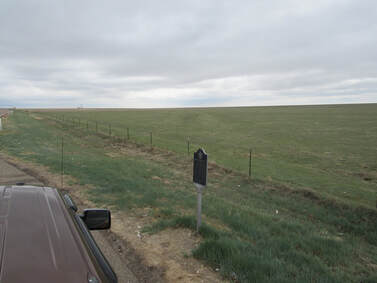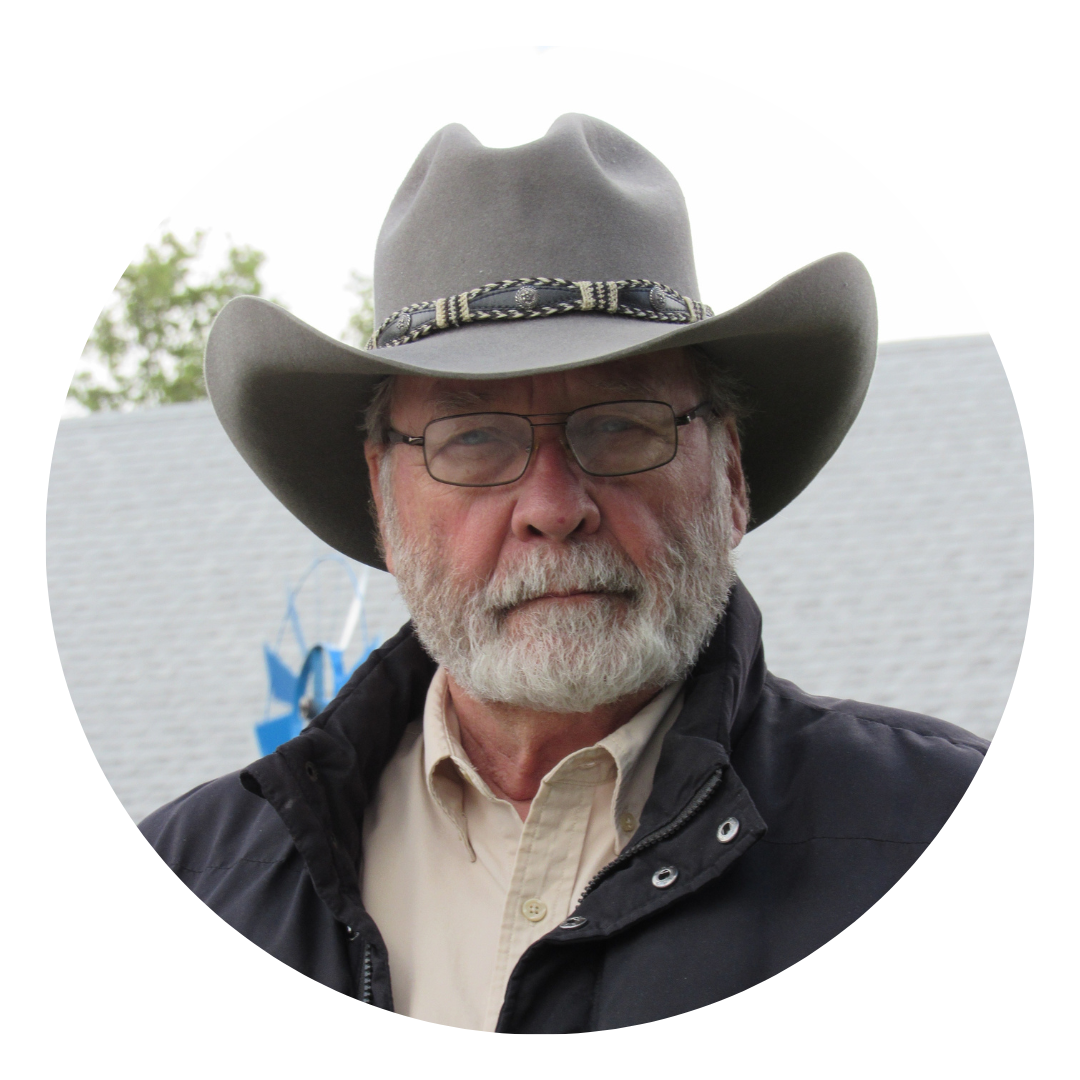 On the campus of Frank Phillips College in Borger, Texas, there are two Texas State Historical markers. One tells of Josiah Gregg, who blazed a wagon trail from Santa Fe to the Mississippi River, while the second talks about the Beale Trail, the first “super-highway” built from Fort Smith, Arkansas, to Los Angeles. These trails were well-used by military expeditions, hunters, and travelers. These two trails overlap each other and are, literally, a few miles from the backyard of my childhood home. I couldn’t see any indication of the trails on the campus, but wagon ruts appear in the lower left-hand corner of the campus on satellite images found by using Google Maps. To see something more up close and personal, I drove Texas Highway 136 between Fritch and Amarillo (about thirty miles from the campus, as the crow flies) to see wagon ruts on a different portion of Gregg’s trail, between FM245 and FM293. Southwest behind a historical marker on the west side of the highway, are wagon “swales”, which are wide depressions in the ground caused by erosion around the ruts. In the picture, there are two swales directly above the sign, in lighter green, probably from wagons traveling side-by-side. In a coming sequel of Smoke Dreams, my characters are on a wagon trip that uses the Beale Road. I knew some information about the Beale before I started writing the story, but to know more, I visited the Hutchinson County Museum in Borger last week. It may be the best place in Texas to learn about the different explorers and the historical wagon trails that were based on the Canadian River. My research proved fascinating and the facts are remarkably important to the history of a town that I thought had little history before the discovery of oil. Here's a synopsis of who did what and when, that can be traced to having used the portion of the Canadian River that lies within Hutchinson County. The Coronado Expedition, 1541: Coronado left his army in the Palo Duro Canyon area and took a small number of men north, crossing the Canadian River and venturing high into central Kansas, looking for Quivira. He was unsuccessful. The Onate Expedition, 1601: Onate established the first capital of Northern Spain, which would eventually be Santa Fe, and then took a force of 300 soldiers, priests, Indians, and servants eastward, followed the Canadian across Texas, through Oklahoma, again looking for Quivira. As with Coronado, the expedition failed. The Mallet Expeditions, 1739-1750: the Mallet brothers were French Canadian traders from New Orleans. They made several trips along the Canadian River (they named it) and the Red River, across Oklahoma, Texas, and into New Mexico. The Pierre Vial routes, 1786-1788: a trader who developed a route from San Antonio to Santa Fe, and also made several different trips from Louisiana to Santa Fe, along the Canadian and Red Rivers, and from Santa Fe to St. Louis along the Arkansas River. Much of this last route became the Santa Fe Trail in 1821. The Stephen Harriman Long expedition, 1820: Long was an explorer, surveyor, and a major in the Corps of Topographical Engineers. He led one the first scientific expeditions to explore the Texas Panhandle, spending about fifteen days there, surveying both the Canadian and Red Rivers. The Abert Expedition, 1845: Lieutenant James William Abert was a soldier, explorer, ornithologist, and topographical artist. He was a member of Captain John Fremont’s expedition to California when, at Bent’s Fort, he was directed to go south and explore the Canadian River from its source in New Mexico to its junction with the Arkansas River in Oklahoma. He wrote splendid reports accompanied by his drawings and watercolor paintings. Unfortunately, except for railroad concerns, all of his information went relatively unnoticed until 1941, when they were rediscovered. The travels of Josiah Gregg, 1831-1852: Gregg was a sickly, shy and studious man, and his doctors recommended he relocate to Santa Fe for his health. He did so, traveling with a merchant caravan along the Santa Fe Trail. He recovered his health and became enamored with traveling; he would eventually cross the Great Plains four times. On one of his trips, he wanted a shorter trail than the Santa Fe Trail and followed the Canadian River going east. He wrote extensively about his journeys and produced Commerce of the Prairies, a popular book that became a cornerstone for all the studies related to the Santa Fe Trail. The Marcy Trail, 1840: Captain Randolph Barnes Marcy was commissioned in 1840 to find a less hazardous route with good water on even terrain that connected Fort Smith, Arkansas, to California. He followed Gregg’s route along the Canadian through Oklahoma, Texas, and New Mexico; followed an existing trail south to El Paso; and then went west across the bottom of Arizona into California. His route was called The California Road. Marcy would later write The Prairie Traveler, published in 1859, which became the principal manual for westward-bound pioneers. The Amiel Weeks Whipple Expedition, 1853: Lt. Whipple was sanctioned with finding a potential route for a transcontinental railroad along the thirty-fifth parallel. Amongst the soldiers, teamsters, herders, and servants of the expedition were scientists closely associated with the Smithsonian Institute. The eight-month effort followed the Marcy Trail across Oklahoma, Texas, and New Mexico, and then surveyed a new route that went directly west from Albuquerque, across the middle of Arizona, to California. Even though a transcontinental route was not located along his route, much of the trail would later be used for the Atchinson, Topeka, and Santa Fe railroad. His expedition produced twelve massive volumes of reports that included contour maps, and helped document the history of the region. The Edward Beale Wagon Road, 1857-1860: Lt. Edward F. Beale and a crew of 100 men and 22 camels, began building the first federal highway west of the Mississippi. One group worked on the easterly route from Fort Smith to Albuquerque, while a second group began a westerly route from New Mexico to the Colorado River. Beale and his crews cleared a 10-foot-wide track, pushing rocks aside, cutting down trees, and building bridges where needed, to make a road spanning 1200 miles from Fort Smith to the Colorado River. His claim was that the route was never more than twenty miles from water, a vital consideration at the time. It followed much of the Whipple route, the Marcy route, and Gregg’s route, and parts of it would later become Route 66 and Interstate 40. After 1865, the story switches from wagon trails to railroad tracks, although there were still wagons making the journey west in the 1880s. Though I doubt it was on a major route, my maternal grandmother remembered coming to Kansas in a covered wagon in the 1890s. I wish I had known this side of the county history when I was in high school. I would have loved to explore the countryside and it would have given me a much higher regard for Panhandle history in general.
0 Comments
Leave a Reply. |
AuthorDon Willerton has been a reader all his life and yearns to write words like the authors he has read. He's working hard at it and invites others to share their experiences. |

 RSS Feed
RSS Feed